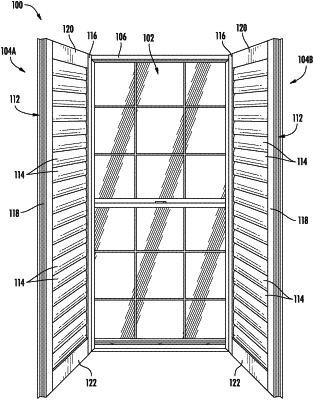| CPC E06B 7/096 (2013.01) [E06B 7/09 (2013.01); E06B 9/04 (2013.01)] | 23 Claims |

|
1. A shutter panel for an architectural opening, said shutter panel comprising:
a frame;
a louver rotatably coupled to said frame, said louver rotatable about a longitudinal axis across an angular travel range comprising a first angular range of louver positions and a second angular range of louver positions, the first angular range of louver positions differing from the second angular range of louver positions; and
a louver closure assembly operable to automatically rotate said louver into a closed position when said louver is moved into the second angular range of louver positions, said louver closure assembly comprising first and second actuators positioned within said frame, said first and second actuators being coupled to said louver such that linear translation of said first and second actuators results in rotation of said louver, said first actuator including a first rack section and a follower member, said second actuator including a second rack section and an engagement section;
wherein:
when said louver is rotated to a louver position within the second angular range of louver positions, said follower member of said first actuator engages said engagement section of said second actuator in a manner such that the engagement of said first and second actuators generates a resultant force applied through said first and second actuators that results in opposed linear translation of said first and second actuators to automatically rotate said louver from said louver position into the closed position;
a tilt gear is positioned between the first and second rack sections and is configured to engage the first and second rack sections such that the opposed linear translation of said first and second actuators results in rotation of said tilt gear; and
said follower member and said first rack section linearly translate together in a first direction with the opposed linear translation of said first and second actuators and said engagement section and said second rack section linearly translate together in an opposed second direction with the opposed linear translation of said first and second actuators.
|